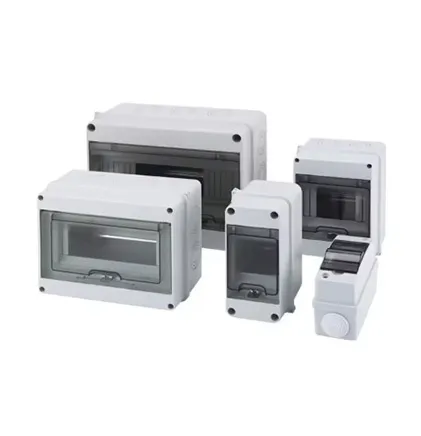
In-Depth Analysis: High-Quality Steel Plate Materials and Surface Treatment Processes for Distribution Boxes

Optimizing Performance Through Material Science and Advanced Processing Technologies
Did you know that microscopic surface imperfections invisible to the naked eye can determine whether a distribution box lasts 5 years or 25? This deep dive reveals how cutting-edge surface treatments transform ordinary steel into industrial superheroes.
The humble distribution box rarely gets attention until it fails, but its reliability shapes our modern infrastructure. Inside these protective shells, cutting-edge electrical assemblies control power flow to factories, hospitals, and neighborhoods. Yet their unsung hero is precisely engineered steel - meticulously processed to withstand weather, corrosion, and electromagnetic stresses.
I. The Steel Performance Trinity: Material, Surface, Structure
Distribution boxes demand a unique trifecta: structural rigidity for protection, electromagnetic compatibility for sensitive electronics, and corrosion resistance for decades-long service. Meeting these requires synergy between three elements:
Real-World Challenge: Offshore Wind Farm Distribution
Salt spray, humidity extremes, and vibration caused catastrophic failures in North Sea installations within 18 months. The solution came through grain-refined electrical steel (3% silicon content) with laser-scanned surface mapping revealing inconsistent coating adhesion. Implementing hybrid shot-peening + ceramic coating extended service life to match turbine durability.
Surface roughness isn't just about aesthetics - it's functional engineering. Microscopic peaks and valleys determine how protective coatings anchor to surfaces. Research reveals ideal Ra values between 0.8-1.6 μm create optimal "tooth" for coating adhesion while minimizing moisture traps. Too smooth, and coatings peel like old wallpaper; too rough, and corrosion starts in the valleys.
II. Surface Metrology Revolution: Beyond the Naked Eye
Traditional metallurgical microscopes reached their limits as quality demands increased. The breakthrough came with laser scanning digital microscopes (LSDM) like the Olympus LEXT OLS4100:
- 3D Topography Mapping : Constructs micron-accurate elevation models detecting peaks/troughs
- Sub-micron Resolution : Reveals corrosion pits measuring just 0.2 μm - smaller than bacteria
- Rapid Analysis : Complete 3D scans in under 30 seconds versus hours with traditional methods
These advanced systems transformed quality control from a reactive chore to proactive precision engineering. One automotive supplier used LSDM data to optimize brake pad friction surfaces, reducing warranty claims by 37%.
Distribution boxes face constant electrical stresses that manifest physically. Surface treatments must balance conductivity and isolation, protection and electromagnetic performance. Without precise control across these functional profiles, failures cascade unpredictably.
III. Modern Rolling Technologies: Where Material Meets Method
China's research in "limiting, composite, intelligent, green" steel processing sets global benchmarks. Innovations driving distribution box quality:
| Technology | Impact on Distribution Boxes |
|---|---|
| Variable Crown Work Rolls | Eliminates thickness variations causing "hot spots" |
| Intelligent Shape Control | Prevents electromagnetic field distortion |
| Corrugated Cold Roll Bonding | Creates layered corrosion-resistant structures |
| Pulse Current Rolling | Enhances grain structure uniformity |
One frontier gaining traction involves electromagnetic roll profile control. By manipulating magnetic fields during rolling, manufacturers achieve precision once thought impossible - reducing thickness tolerance windows from ±15 μm to ±3 μm.
IV. Coating Breakthroughs: The Final Defense Layer
The evolution beyond traditional galvanization features nano-engineered solutions:
- Graphene-Enhanced Ceramics : Thermal spraying creates composite layers with 3× abrasion resistance
- Self-Healing Polymers : Microcapsules release corrosion inhibitors when damage occurs
- Electrodeposited Nanocoatings : Uniform sub-micron layers maintain electrical properties
Railway Power Distribution Case
Accelerated corrosion at welded joints caused repeated failures in signal distribution boxes. Implementing a hybrid approach: zinc-nickel electroplating as base layer + moisture-cured polyurethane topcoat reduced maintenance frequency from biannual to once every 7 years.
The distribution box becomes more than an accessory; it transforms into a system safeguarding connectivity and power delivery. This responsibility demands steel performance exceeding expectations through cutting-edge materials and processes. As infrastructure ages amid intensifying environmental pressures, these innovations shift asset management from constant repair to reliable protection.
V. Future Horizons: What's Next for Distribution Box Materials?
Emerging innovations set to transform the field:
- Smart Coatings : Color-changing films indicating substrate degradation
- Digital Twins : Simulating corrosion progression through real-time data
- Additive Hybrid Manufacturing : Incorporating non-metallic reinforcements selectively
Already, researchers are exploring biomimetic surfaces inspired by mangrove roots and lotus leaves. Early tests show nature-inspired micro-textures significantly reduce moisture retention - extending service life in humid environments.
The journey from raw steel sheet to weather-resistant power guardian involves orchestrated scientific artistry. Through layered surface engineering, manufacturers turn vulnerable metal into resilient protection. Each micron of coating, each optimized grain structure, contributes to distribution boxes that guard vital infrastructure through storms and decades.
What makes this evolution crucial? Simply put: modern life runs on uninterrupted power. Behind every flick of a light switch, every functioning traffic signal, every operating room monitor stands these unassuming steel sentinels. Their quality determines whether communities experience darkness or dependability. Through advances in material science, the protective shield grows stronger.
Tags:
Recommend Products











